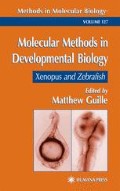Abstract
Zebrafish (Danio rerio) embryos have gained considerable popularity in recent years because they offer several advantages for developmental studies. The embryos are easy to manipulate, develop quite rapidly, and many genetic mutations are now becoming available. Classical cell and tissue transplantation techniques have been frequently applied to zebrafish embryos to analyze the state of cell commitment, inductive interaction between embryonic tissues and defective tissues in mutant embryos. This chapter introduces three kinds of transplantation techniques useful for the analysis of early inductive events in zebrafish embryos, such as mesoderm and neural induction.
Access this chapter
Tax calculation will be finalised at checkout
Purchases are for personal use only
References
Long, W. L. (1983) The role of the yolk syncytial layer in determination of the plane of bilateral symmetry in the rainbow trout, Salmo gairdneri Richardson. J. Exp. Zool. 228, 91–97.
Mizuno, T., Yamaha, E., Wakahara, M., Kuroiwa, A., and Takeda H. (1996) Mesoderm induction in zebrafish. Nature 383, 131–132.
Scharf, R. R. and Gerhart, J. C. (1983) Axis determination in eggs of Xenopus laevis: a critical period before first cleavage, identified by the common effects of cold, pressure and ultraviolet irradiation. Dev. Biol. 99, 75–87.
Strähle, U. and Jesuthasan, S. (1993) Ultraviolet irradiation impairs epiboly in zebrafish embryos: evidence for a microtubule-dependent mechanism of epiboly. Development 119, 909–919.
Mizuno, T., Yamaha, E., and Yamazaki, F. (1997) Localized axis determinant in the early cleavage embryo of the goldfish, Carassius auratus. Dev. Genes Evol. 206, 389–396.
Gerhart, J., Danilchik, M., Doniach, T., Roberts, S., Rowning, B., and Stewart, R. (1989) Cortical rotation of the Xenopus egg: consequences for the anteroposterior pattern of embryonic dorsal development. Development 107(Suppl.), 37–51.
Westerfield, M. (1993) The Zebrafish Book: A Guide for the Laboratory Use of Zebrafish (Danio rerio), University of Oregon Press, Eugene, OR.
Yamaha, E. and Yamazaki, F. (1993) Electrically fused-egg induction and its development in the goldfish, Carassius auratus. Int. J. Dev. Biol. 37, 291–298.
Tonegawa, A., Funayama, N., Ueno, N., and Takahashi, Y. (1997) Mesodermal subdivision along the mediolateral axis in the chicken controlled by different concentrations of BMP-4. Development 124, 1975–1984.
Miyagawa, T., Amanuma, H., Kuroiwa, A., and Takeda, H. (1997) Specification of posterior midbrain region in zebrafish neuroepithelium. Genes Cells 1, 369–377.
Tung, T. C., Chang, C. Y., and Tung, Y. F. Y. (1945) Experiments on the developmental potencies of blastoderms and fragments of Teleostean eggs separated latitudianally. Proc. Zool. Sci. 115, 175–188.
Hatta, K. and Takahashi, Y. (1996) Secondary axis induction by heterospecific organizers in zebrafish. Develop. Dynam. 205, 183–195.
Shih, J. and Fraser, S. E. (1996) Characterizing the zebrafish organizer: microsurgical analysis at the early shield stage. Development 122, 1313–1322.
Mizuno, T., Yamaha, E., Kuroiwa, A., and Takeda, H. (1999) Removal of vegetal yolk causes doral deficiencies and impairs doral-inducing ability of the yolk cell in zebrafish. Mech. Dev., in press.
Koshida, S., Shinya, M., Mizuno, T., Kuroiwa, A., and Takeda, H. (1998) Initial anteroposterior pattern of the zebrafish central nervous system is determined by differential competence of the epiblast. Development 125, 1957–1966.
Author information
Authors and Affiliations
Editor information
Editors and Affiliations
Rights and permissions
Copyright information
© 1999 Humana Press Inc.
About this protocol
Cite this protocol
Mizuno, T., Shinya, M., Takeda, H. (1999). Cell and Tissue Transplantation in Zebrafish Embryos. In: Guille, M. (eds) Molecular Methods in Developmental Biology. Methods in Molecular Biology™, vol 127. Humana Press. https://doi.org/10.1385/1-59259-678-9:15
Download citation
DOI: https://doi.org/10.1385/1-59259-678-9:15
Publisher Name: Humana Press
Print ISBN: 978-0-89603-790-8
Online ISBN: 978-1-59259-678-2
eBook Packages: Springer Protocols

